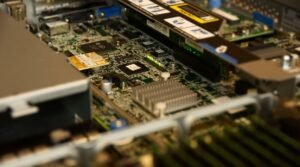AI Automation Workflow
Artificial Intelligence (AI) and automation technologies have revolutionized workflows across industries, making tasks faster, efficient, and error-free. By leveraging AI-powered tools, businesses can streamline their operations, reduce costs, and improve productivity. In this article, we will explore the key components of an AI automation workflow and how it benefits organizations.
Key Takeaways
- AI automation enhances efficiency and productivity.
- It saves time, reduces errors, and minimizes manual intervention.
- Organizations can leverage AI technologies to optimize workflows and improve customer experiences.
- By automating repetitive tasks, employees can focus on higher-value activities.
An AI automation workflow consists of several stages that help businesses achieve their goals effectively. The process begins with data collection and analysis, where massive amounts of data are collected from various sources, including customer interactions, transactions, and social media. This step is crucial as it provides the foundation for AI-driven decision-making.
Next, machine learning algorithms are employed to process the data and uncover meaningful patterns, trends, and insights. These algorithms use statistical techniques to learn from the data and make predictions or recommendations. The more data they process, the better they become at refining their models.
Once the insights are obtained, the AI system moves on to the automation phase. This involves utilizing intelligent algorithms and robotic process automation (RPA) to carry out tasks that were previously performed manually. This not only saves time but also reduces errors caused by human intervention.
Interesting Fact: According to a McKinsey report, organizations that have automated their workflows using AI and automation technologies have witnessed productivity improvements of up to 20%.
After the automation phase, the AI system can optimize and refine its performance through continuous learning. By analyzing feedback and outcomes, the algorithms can learn from their mistakes and adapt to changing scenarios, improving the accuracy and efficiency of their predictions and recommendations.
The Benefits of AI Automation Workflow
Implementing an AI automation workflow offers numerous benefits for organizations:
- Increased Efficiency: AI-driven automation helps organizations complete tasks faster by eliminating manual interventions.
- Reduced Errors: Automation minimizes human errors, resulting in higher accuracy and improved quality of work.
- Cost Savings: By automating repetitive tasks, organizations can reduce their labor costs and allocate resources more efficiently.
- Better Customer Experiences: AI automation can improve customer service by providing personalized recommendations and faster response times.
- Employee Empowerment: By automating mundane tasks, employees can focus on more creative and strategic activities, leading to higher job satisfaction.
Data Privacy and Security
While AI automation offers tremendous advantages, organizations must address data privacy and security concerns when implementing an AI automation workflow. Safeguarding sensitive customer information should be a top priority. This can be achieved through stringent data access controls, encryption techniques, and compliance with data protection regulations.
AI Automation in Different Industries
AI automation has disrupted various industries, enhancing productivity, and creating new opportunities. Let’s explore a few examples:
| Industry | Use Case |
|---|---|
| Healthcare | AI-enabled diagnosis, robotic surgeries, and automated patient record keeping |
| Manufacturing | Robotics and automation in assembly lines, predictive maintenance, and inventory management |
| Finance | Automated fraud detection, algorithmic trading, and loan underwriting |
Challenges and Future Outlook
Although AI automation brings numerous benefits, there are challenges to consider. Automation can lead to job displacement, requiring organizations to reskill or upskill their workforce. Additionally, ensuring the ethical use of AI is essential to avoid bias or discrimination.
Interesting Fact: According to Gartner, by 2024, organizations using AI automation will witness a 30% increase in their productivity levels.
As technology advances, the future of AI automation looks promising. Intelligent automation, AI-powered chatbots, and further integration with IoT devices will reshape workflows and unlock even greater efficiency gains for businesses worldwide.

Common Misconceptions
Misconception 1: AI Automation Replaces Human Workers
One common misconception about AI automation is that it will completely replace human workers. While AI technology can automate certain tasks, it is not designed to replace humans entirely. Humans are still needed to oversee and manage the AI systems, make strategic decisions, and provide the human touch that AI lacks.
- AI automation complements human workers
- Human oversight is crucial for AI systems
- AI can handle repetitive and mundane tasks, freeing up humans for more creative work
Misconception 2: AI Automation is Expensive and Complex
Another misconception is that implementing AI automation is a costly and complex process. While AI technology may require an initial investment, it can result in long-term cost savings and efficiency improvements. Additionally, with advancements in technology, AI solutions are becoming more user-friendly and accessible to businesses of all sizes.
- Initial investment can lead to long-term cost savings
- Advancements in technology make AI solutions more accessible
- AI can improve operational efficiency and productivity
Misconception 3: AI Automation will Lead to Job Losses
There is a common fear that AI automation will lead to mass job losses. While AI may replace some jobs that involve repetitive tasks, it also creates new job opportunities. As AI takes over manual and mundane tasks, it allows humans to focus on more complex and creative tasks, thus promoting job growth and innovation.
- AI creates new job opportunities
- Humans can focus on complex and creative tasks
- Job roles can evolve to work alongside AI technology
Misconception 4: AI Automation is Perfect and Error-Free
Contrary to popular belief, AI automation is not flawless. AI systems can still make mistakes and require continuous human monitoring and intervention. They are only as good as the data they are trained on, and biases in the data can affect their performance. Regular maintenance, updates, and retraining are necessary to ensure the accuracy and effectiveness of AI systems.
- AI systems require human monitoring and intervention
- Data biases can affect AI performance
- Regular maintenance and retraining are crucial for accuracy
Misconception 5: AI Automation will Replace the Need for Human Creativity
While AI can perform tasks that are rule-based and repetitive, it does not possess the creative thinking and problem-solving abilities of humans. Human creativity and intuition are still essential for innovation and certain decision-making processes. AI can assist and augment human creativity, but it cannot completely replace it.
- Human creativity is crucial for innovation
- AI can augment human creativity
- Certain decision-making processes require human intuition

AI Automation Workflow: Boosting Efficiency in Business Processes
Automatic workflow powered by artificial intelligence (AI) is transforming the way businesses operate. AI technologies are assisting organizations in streamlining complex tasks, reducing human error, and improving overall efficiency. This article examines ten real-world examples of AI automation in various industries.
1. Customer Service Response Time
AI-powered chatbots drastically reduce response times for customer inquiries, providing instant support and enhancing user experience.
2. Fraud Detection in Banking
AI algorithms analyze vast amounts of financial data to detect fraudulent activities and flag suspicious transactions, strengthening security measures in banking institutions.
3. Inventory Management Optimization
AI systems gather real-time data on stock levels, demand patterns, and supply chain operations, leading to smarter inventory management and minimized stockouts.
4. Healthcare Diagnostics
AI-based medical imaging tools accurately detect abnormalities in X-rays, MRIs, and CT scans, assisting doctors in diagnosing diseases and improving patient outcomes.
5. Predictive Maintenance in Manufacturing
A combination of AI and Internet of Things (IoT) sensors monitors machinery conditions, predicting maintenance needs and preventing costly breakdowns.
6. Personalized Marketing Campaigns
AI algorithms analyze customer data, enabling businesses to create tailored marketing campaigns that cater directly to individual preferences and interests.
7. Energy Consumption Optimization
AI-powered systems monitor and analyze energy usage patterns, enabling businesses to identify areas of inefficiency and implement energy-saving measures.
8. Language Translation and Interpretation
AI language processing systems translate written content and interpret spoken conversations, bridging language barriers and facilitating global communication.
9. Autonomous Vehicle Navigation
AI algorithms guide self-driving cars, analyzing real-time road conditions, traffic patterns, and potential hazards, ensuring safe and efficient transportation.
10. Content Generation and Curation
AI algorithms automatically generate and curate content, assisting marketers, journalists, and publishers in creating engaging articles, videos, and social media posts.
Through the examples above, it is evident that AI automation is revolutionizing various industries, enabling organizations to streamline operations, increase productivity, and improve overall customer satisfaction. With continued advancements in AI technology, we can expect even greater efficiency and innovation in the future.
AI Automation Workflow – Frequently Asked Questions
What is AI Automation Workflow?
AI Automation Workflow refers to the process of utilizing artificial intelligence algorithms and technologies to automate different tasks and workflows in various industries and sectors. It involves the use of machine learning, natural language processing, and computer vision to streamline and optimize processes, increase efficiency, and reduce human intervention.
How does AI Automation Workflow work?
AI Automation Workflow works by leveraging advanced AI techniques to automate repetitive tasks and complex workflows. It typically involves the collection and analysis of large amounts of data, training AI models to recognize patterns and make predictions, and deploying these models to automate tasks in real-time. AI Automation Workflow systems can perform tasks such as data entry, data analysis, document processing, customer support, and more.
What are the benefits of AI Automation Workflow?
AI Automation Workflow offers several benefits, including:
- Increased productivity and efficiency
- Improved accuracy and quality of work
- Reduced operational costs
- Faster processing and response times
- Elimination of repetitive and mundane tasks
- Enablement of 24/7 operations
What industries can benefit from AI Automation Workflow?
AI Automation Workflow can benefit various industries, including:
- Finance and banking
- Healthcare
- Retail and e-commerce
- Manufacturing
- Customer service
- Human resources
What are some examples of AI Automation Workflow in action?
Examples of AI Automation Workflow include:
- Automated chatbots for customer support
- Intelligent document processing systems
- Robotic process automation (RPA)
- AI-powered recommendation engines
- Automated data analysis and reporting
What are the challenges of implementing AI Automation Workflow?
Implementing AI Automation Workflow can present challenges such as:
- Availability of high-quality training data
- Integration with existing systems and processes
- Ensuring data privacy and security
- Managing change and employee adoption
- Addressing ethical concerns
What skills are required to implement AI Automation Workflow?
Implementing AI Automation Workflow requires a combination of technical and domain-specific skills, including:
- Proficiency in programming languages (e.g., Python, Java)
- Data analytics and machine learning knowledge
- Understanding of AI algorithms and techniques
- Domain expertise in the industry being automated
What are the future trends in AI Automation Workflow?
The future trends in AI Automation Workflow include:
- Increased adoption of AI-powered virtual assistants
- Advancements in natural language processing and understanding
- Integration of AI with Internet of Things (IoT) devices
- Expansion of AI automation capabilities across industries
How can I get started with implementing AI Automation Workflow?
To get started with implementing AI Automation Workflow, you can:
- Identify repetitive tasks or workflows that can be automated
- Assess the availability and quality of data for training AI models
- Explore AI automation platforms and tools
- Seek expert guidance or partner with AI automation consultants





